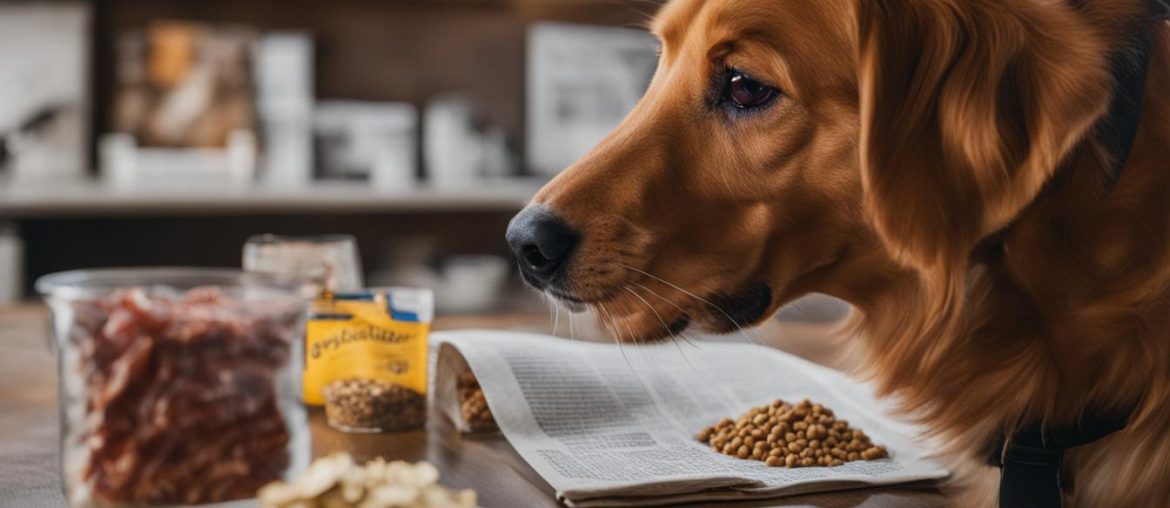Welcome to this article where we delve into the question: is bacon grease good for dogs? Many pet owners wonder about the benefits of bacon grease for their furry friends, but it’s important to understand the potential risks and drawbacks before incorporating it into their diets. In this comprehensive guide, we will explore the health effects of bacon grease on dogs and provide safer alternatives for adding flavor to their meals. Let’s prioritize our dogs’ health and well-being by making informed choices about their nutrition.
Key Takeaways:
- Bacon grease is high in fat and can lead to digestive issues in dogs.
- Consuming large amounts of bacon grease may cause pancreatitis, a painful inflammation of the pancreas.
- Bacon grease can contribute to weight gain and obesity in dogs.
- There are safer alternatives to bacon grease for adding flavor to dogs’ meals.
- Responsible pet ownership involves prioritizing dogs’ health and consulting with a veterinarian for dietary guidance.
The Risks of Feeding Dogs Bacon Grease

Feeding dogs bacon grease may seem like a tasty treat, but it’s important to be aware of the potential risks it poses to their health. Bacon grease is high in fat, which can lead to a variety of issues in dogs, including pancreatitis.
Pancreatitis is a painful inflammation of the pancreas that can be triggered by the consumption of high-fat foods like bacon grease. Symptoms of pancreatitis in dogs include vomiting, diarrhea, abdominal pain, and decreased appetite. If left untreated, pancreatitis can be life-threatening.
In addition to pancreatitis, feeding dogs bacon grease can also contribute to weight gain and obesity. This excess weight can put strain on their joints and increase the risk of developing heart disease. It’s important to consider the long-term health consequences before incorporating bacon grease into a dog’s diet.
| Risks of Feeding Dogs Bacon Grease |
|---|
| Potential triggers of pancreatitis |
| Increased risk of weight gain and obesity |
| Possible development of joint issues and heart disease |
When it comes to feeding dogs, it’s best to prioritize their health and choose safer alternatives to bacon grease. There are many other food supplements and flavor options available that can provide a tasty and nutritious addition to their meals. Consulting with a veterinarian can help determine the most appropriate options for your dog’s dietary needs.
Feeding Dogs Bacon Grease Safely
If you still decide to occasionally give your dog a small amount of bacon grease as a special treat, it’s important to do so safely. Here are some tips to keep in mind:
- Limit the amount of bacon grease given to your dog. A small dab or teaspoon is sufficient.
- Ensure the bacon grease is fully cooled before offering it to your dog. Hot grease can cause burns or other injuries.
- Monitor your dog closely for any adverse reactions. If they show signs of digestive distress or discomfort, discontinue feeding them bacon grease.
Remember, it’s always best to err on the side of caution and choose healthier alternatives for your dog’s diet. Their long-term health and well-being should be the top priority.
The Health Effects of Bacon Grease on Dogs
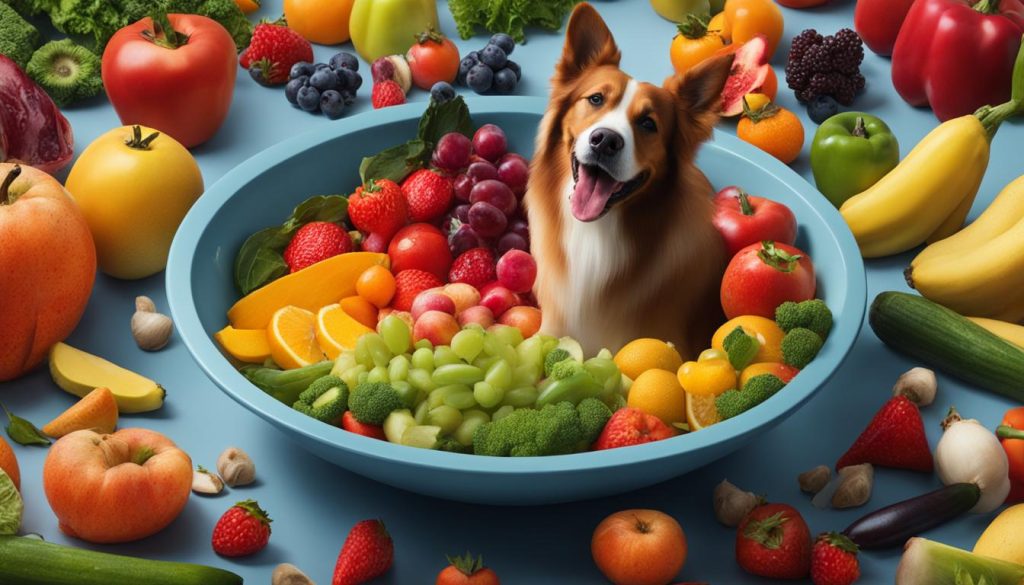
When it comes to the health effects of bacon grease on dogs, it’s important to understand that this fatty substance is not a nutritious option for our furry friends. Bacon grease is high in fat content, which can be detrimental to a dog’s digestive system. Consuming bacon grease can lead to various health issues, such as digestive upset and even more severe conditions like pancreatitis.
While some pet owners may believe that a small amount of bacon grease won’t harm their dogs, it’s essential to remember that even small quantities can contribute to weight gain and obesity. These conditions can lead to additional health problems, including joint issues and heart disease. As responsible pet owners, we must prioritize our dogs’ well-being and choose healthier alternatives for their diets.
The Importance of Choosing Healthier Alternatives
When it comes to dog nutrition, there are several alternatives to bacon grease that can provide more balanced nutrition for our furry friends. Lean, cooked meats without added seasonings or low-sodium broths serve as excellent alternatives. These options offer a flavorful addition to their meals without the risks associated with bacon grease.
Incorporating a variety of fresh fruits and vegetables can also provide essential nutrients for dogs. It’s important to consult with a veterinarian to determine the best dietary options for each individual dog and their specific needs. By making informed choices and prioritizing our dogs’ health, we can ensure they receive a well-rounded and nutritious diet.
| Health Effects of Bacon Grease on Dogs | Healthier Alternatives |
|---|---|
| High fat content | Lean, cooked meats |
| Potential digestive issues | Low-sodium broths |
| Weight gain and obesity | Fresh fruits and vegetables |
| Risks of pancreatitis | Consulting with a veterinarian |
To summarize, bacon grease is not a suitable option for dogs’ nutrition due to its high fat content and potential health risks. By choosing healthier alternatives, such as lean meats, low-sodium broths, and fresh fruits and vegetables, we can ensure our dogs receive the balanced nutrition they need. It’s essential to prioritize our dogs’ health and consult with a veterinarian to make informed decisions about their diets.
Can Dogs Eat Bacon?
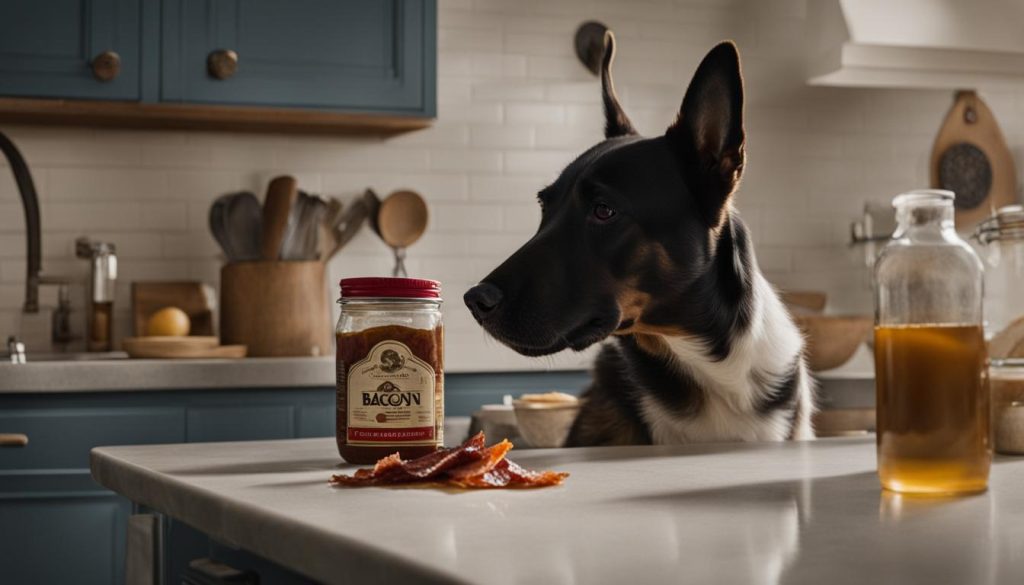
Many dog owners wonder whether it is safe to feed their furry companions bacon. While a small piece of bacon may not harm your dog, it’s important to exercise caution and limit their bacon intake. Bacon is high in fat and salt, which can lead to various health issues in dogs. Consuming too much bacon or bacon grease can increase the risk of pancreatitis, a painful inflammation of the pancreas. It can also contribute to weight gain, obesity, and digestive problems in dogs.
It’s essential to choose healthier alternatives for your dog’s diet to ensure their long-term health and well-being. Turkey bacon can be a safer option as it is lower in fat and salt compared to regular bacon. However, it should still be given only as an occasional treat. It’s important to remember that each dog is unique, and their dietary needs can vary. Consulting with a veterinarian can help you determine the best diet and treats for your dog based on their individual health and nutritional requirements.
Comparing Bacon and Turkey Bacon Nutrition
| Bacon (1 slice) | Turkey Bacon (1 slice) | |
|---|---|---|
| Calories | 43 | 30 |
| Total Fat (grams) | 3.9 | 1.7 |
| Sodium (milligrams) | 137 | 222 |
As seen in the table above, turkey bacon has lower calorie, fat, and sodium content compared to bacon. This makes it a relatively healthier option for dogs. However, it’s crucial to remember that both bacon and turkey bacon should be given in moderation and as an occasional treat rather than a regular part of their diet.
When it comes to your dog’s diet, it’s best to prioritize their health and choose nutritionally balanced options. There are plenty of safer alternatives to bacon, such as lean, cooked meats without added seasonings, low-sodium broths, or even specialized dog treats. By providing your dog with a well-rounded diet and consulting with a veterinarian, you can ensure they receive the necessary nutrients while minimizing the risk of health issues.
Responsible Pet Ownership and Dog Nutrition
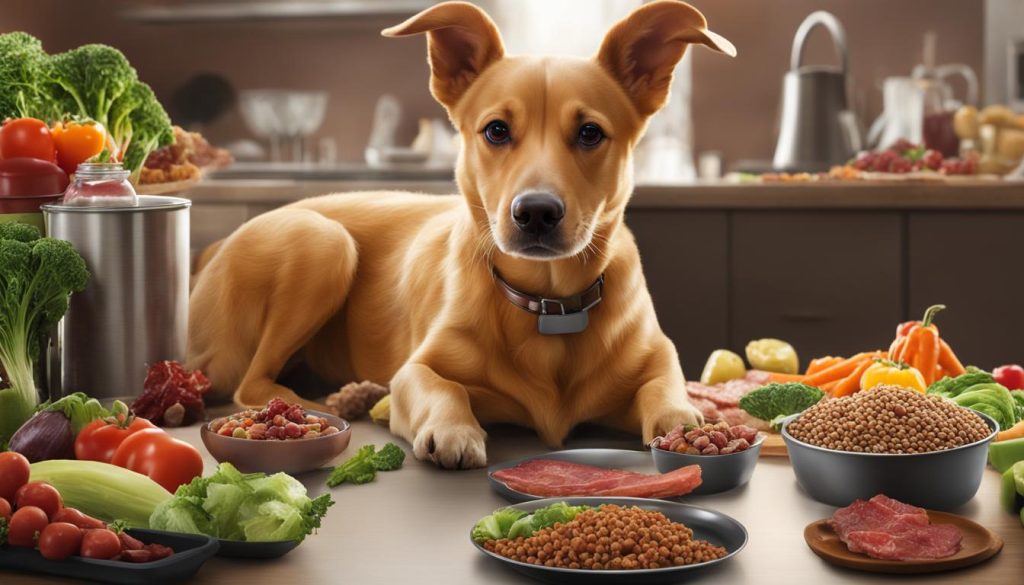
As a responsible pet owner, ensuring your dog’s nutrition is a top priority. Providing a balanced and nutritious diet is crucial for their overall health and well-being. By understanding their dietary needs and making informed choices, you can help promote a long and active life for your furry friend.
Dogs have specific dietary requirements that must be met to maintain optimal health. These requirements include a combination of proteins, carbohydrates, fats, vitamins, and minerals. It’s important to choose high-quality dog food that is formulated to meet these needs. Consulting with a veterinarian can help determine the right type and amount of food for your dog based on their age, breed, size, and activity level.
In addition to a well-balanced diet, it’s essential to avoid feeding your dog unhealthy treats like bacon grease. While it may be tempting to share indulgent foods with your pet, bacon grease is high in fat and can lead to digestive issues, weight gain, and even more serious conditions like pancreatitis. Instead, consider alternative flavors such as low-sodium chicken or beef broth to enhance the taste of their meals without compromising their health.
Tips for responsible pet ownership and dog nutrition:
- Choose a high-quality dog food that meets your dog’s nutritional needs.
- Consult with a veterinarian to determine the right type and amount of food for your dog.
- Avoid feeding your dog unhealthy treats like bacon grease.
- Consider alternative flavors such as low-sodium chicken or beef broth to add variety to their meals.
- Monitor your dog’s weight and adjust their food intake accordingly to prevent obesity.
- Provide plenty of fresh water at all times.
- Regularly exercise your dog to maintain a healthy weight and promote overall fitness.
By following these guidelines for responsible pet ownership and prioritizing your dog’s nutrition, you can ensure they lead a happy and healthy life. Remember, a nutritious diet is the foundation of a thriving pet, and your furry friend will thank you for it.
| Nutritional Needs | Proteins | Carbohydrates | Fats | Vitamins | Minerals |
|---|---|---|---|---|---|
| Importance | Essential for muscle repair and growth. | Provide energy for daily activities. | Aids in digestion and nutrient absorption. | Support a healthy immune system. | Regulate bodily functions and promote strong bones. |
| Sources | Meat, poultry, fish, eggs, dairy products. | Grains, fruits, vegetables. | Oils, fatty fish, nuts, seeds. | Fruits, vegetables, organ meats. | Fruits, vegetables, legumes, dairy products. |
Symptoms of Bacon Grease Consumption in Dogs
Consuming bacon grease can have adverse effects on dogs’ health, leading to various symptoms that indicate digestive issues. If your dog has ingested bacon grease, it’s crucial to be aware of the potential symptoms of complications. These symptoms may include:
- Vomiting
- Diarrhea
- Abdominal pain
- Decreased appetite
- Lethargy
These symptoms may indicate pancreatitis, a painful inflammation of the pancreas that can occur due to the high fat content of bacon grease. Pancreatitis is a serious condition that requires immediate attention from a veterinarian.
If you notice any of these symptoms in your dog after consuming bacon grease, it’s important to seek veterinary advice promptly. Early intervention can help prevent further complications and ensure the well-being of your furry companion.
Table: Symptoms of Bacon Grease Consumption in Dogs
| Symptoms | Description |
|---|---|
| Vomiting | Expelling the contents of the stomach forcefully through the mouth |
| Diarrhea | Loose or watery stools |
| Abdominal pain | Discomfort or distress in the abdominal area |
| Decreased appetite | Lack of interest in food or reduced desire to eat |
| Lethargy | Lack of energy or enthusiasm, excessive tiredness |
Recognizing these symptoms is crucial because early detection and prompt veterinary care can greatly improve your dog’s chances of a full recovery. It’s important to remember that bacon grease, along with other high-fat foods, should be avoided in your dog’s diet to prioritize their health and well-being.
Can Dogs Eat Bacon as a Treat?
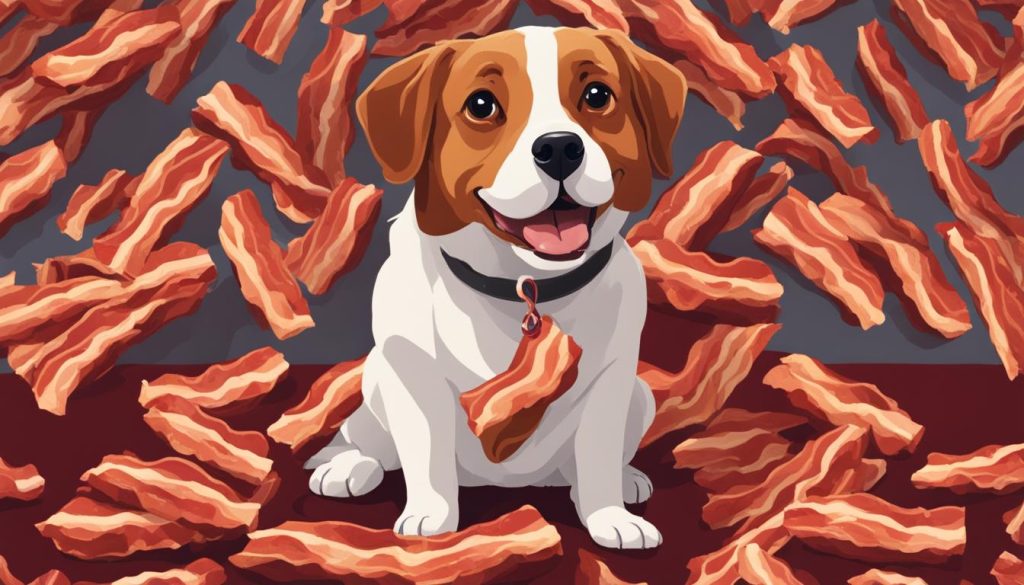
Feeding dogs bacon as a treat may seem like a special indulgence, but it’s important to consider the potential risks and impact on their health. Bacon is high in salt and fat, which can have detrimental effects on dogs, especially when consumed in excess. While a small piece of bacon may not immediately harm dogs, it’s best to avoid making it a regular part of their diet.
One of the main concerns with feeding dogs bacon is the increased risk of pancreatitis. Pancreatitis is a painful condition characterized by inflammation of the pancreas and can be life-threatening for dogs. Signs of pancreatitis in dogs include lethargy, dehydration, vomiting, loss of appetite, a hunched back, and fever. If any of these symptoms are observed after a dog consumes bacon, it is crucial to seek veterinary assistance immediately.
It’s important to remember that dogs have different dietary needs and sensitivities than humans. While bacon may be a beloved treat for many people, it is not a suitable choice for dogs. Instead, there are safer alternatives to consider when looking for special treats or rewards for your furry friend. Opting for dog-friendly treats or fruits and vegetables that are safe for dogs can provide them with a healthier alternative to bacon.
When it comes to treating our dogs, it’s essential to prioritize their overall well-being. While the occasional bacon treat may not cause immediate harm, it’s best to err on the side of caution and choose safer options. Remember to consult with a veterinarian for guidance on suitable treats and to ensure your dog’s diet remains balanced and tailored to their specific nutritional needs.
What to Do If Your Dog Consumes Too Much Bacon

If your dog has consumed too much bacon, it is important to take the necessary steps to ensure their health and well-being. While bacon is tasty and tempting, it can pose risks to dogs due to its high fat and salt content. Here are some actions you can take if your furry friend has indulged in an excessive amount of bacon:
1. Monitor Their Symptoms
Keep a close eye on your dog for the next few days and watch for any signs of gastrointestinal distress. Common symptoms of excessive bacon consumption include vomiting, diarrhea, and abdominal discomfort. If these symptoms persist or worsen, it’s important to seek veterinary advice immediately.
2. Adjust Their Diet
To help settle your dog’s stomach, consider adjusting their diet temporarily. Offer them small, light meals consisting of easily digestible foods like boiled, boneless, skinless chicken and white rice. These bland options can help soothe their digestive system and alleviate discomfort.
3. Provide Plenty of Water
Ensure that your dog has access to fresh, clean water at all times. Hydration is important to help flush out any toxins and restore balance to their system. Encourage them to drink regularly and monitor their water intake to ensure they stay hydrated.
4. Seek Veterinary Advice
If your dog’s symptoms persist, worsen, or if you are unsure about how to proceed, it is always best to consult with a veterinarian. They can provide professional guidance and determine if any further medical intervention is necessary to ensure your dog’s health and well-being.
| Symptoms to Monitor | Recommended Actions |
|---|---|
| Vomiting, diarrhea, and abdominal discomfort | Monitor symptoms closely and seek veterinary advice if they persist or worsen |
| Adjustment in diet | Offer small, light meals of boiled, boneless, skinless chicken and white rice to soothe their stomach |
| Hydration | Ensure access to fresh water and encourage regular drinking |
| Consult a veterinarian | Seek professional guidance if symptoms persist, worsen, or if unsure about the best course of action |
Remember, prevention is always better than cure. It is important to keep potentially harmful foods like bacon out of your dog’s reach and provide them with a balanced and nutritious diet that meets their specific dietary needs. By prioritizing their health and well-being, you can help ensure that your beloved canine companion leads a happy and healthy life.
Safer Options for Adding Flavor to Dogs’ Meals
When it comes to adding flavor to our dogs’ meals, there are safer alternatives to bacon grease that can still provide a tasty and enjoyable experience. By choosing options that are low in fat and seasonings, we can ensure our dogs’ safety and overall well-being. Here are a few alternatives that you can consider:
- Low-sodium chicken or beef broth: Adding a small amount of low-sodium broth to your dog’s food can provide a flavorful alternative to bacon grease. It’s important to choose broths that are specifically labeled as low in sodium to avoid any unnecessary health risks.
- Lean, cooked meats: Opting for lean, cooked meats without added seasonings or spices can be a great way to enhance the taste of your dog’s meal. Make sure to remove any visible fat or skin before serving the meat to your furry friend.
- Vegetable purees: Certain vegetables, such as sweet potatoes or carrots, can be cooked, mashed, and added to your dog’s food for added flavor. These vegetable purees can also provide additional nutrients and dietary fiber.
Remember, it’s important to introduce any new flavors or ingredients gradually to ensure that your dog tolerates them well. Always consult with your veterinarian before making any significant changes to your dog’s diet.
By choosing these safer alternatives, we can provide our dogs with a flavorful and nutritious meal without the potential risks associated with bacon grease. Prioritizing their health and well-being is crucial in being a responsible pet owner.
Table: Safer Options for Adding Flavor to Dogs’ Meals
| Option | Description |
|---|---|
| Low-sodium chicken or beef broth | Flavorful alternative to bacon grease, choose low-sodium options |
| Lean, cooked meats | Remove visible fat or skin before serving, can enhance taste |
| Vegetable purees | Cooked, mashed vegetables like sweet potatoes or carrots for added flavor and nutrients |
Guidelines for Feeding Dogs a Healthy Diet
Feeding dogs a healthy diet is essential for their overall well-being and longevity. By following these guidelines, you can ensure that your furry companion receives the necessary nutrients and maintains a healthy weight.
1. Choose High-Quality Dog Food
Selecting a high-quality dog food is the foundation of a healthy diet. Look for options that contain real meat as the main ingredient, such as chicken, beef, or fish. Avoid dog foods that use fillers and artificial additives. Check the label for a statement from the Association of American Feed Control Officials (AAFCO) confirming that the food meets the nutritional standards for a complete and balanced diet.
2. Follow Portion Control
Portion control is crucial to prevent overfeeding and maintain a healthy weight for your dog. Consult with your veterinarian to determine the appropriate portion size based on your dog’s age, weight, and activity level. It’s important to measure the food accurately and avoid feeding table scraps or excessive treats, as these can contribute to weight gain and nutritional imbalances.
3. Incorporate Fresh Fruits and Vegetables
In addition to high-quality dog food, fresh fruits and vegetables can provide essential vitamins, minerals, and dietary fiber. Some dog-friendly options include carrots, green beans, blueberries, and apples (without seeds). Chop or cook the fruits and vegetables to make them easier for your dog to digest.
4. Offer Lean Protein Sources
Lean protein sources like cooked chicken, turkey, or lean cuts of beef can be added to your dog’s diet to provide additional flavor and nutrients. Remove any skin, bones, and excessive fat before serving. Avoid seasoning with ingredients like salt, garlic, or onions, as these can be harmful to dogs.
Remember to provide fresh, clean water at all times, and monitor your dog’s weight and overall health regularly. If you have any concerns or questions about your dog’s diet, consult with a veterinarian for personalized advice.
| Guidelines for Feeding Dogs a Healthy Diet |
|---|
| Choose High-Quality Dog Food |
| Follow Portion Control |
| Incorporate Fresh Fruits and Vegetables |
| Offer Lean Protein Sources |
Wrapping Up
After careful consideration, it is clear that bacon grease is not a suitable addition to dogs’ diets. As responsible pet owners, we must prioritize the health and well-being of our furry companions. While bacon grease may be tempting to share, its high fat content and associated risks make it an unhealthy choice for our dogs.
Instead, we should explore healthier alternatives and consult with veterinarians to ensure our dogs receive a balanced and nutritious diet. By choosing lean, cooked meats without added seasonings, or small amounts of low-sodium chicken or beef broth, we can provide a flavorful and safe option for dogs without compromising their health.
Responsible pet ownership means making informed choices about dog nutrition. By understanding the potential risks of feeding dogs bacon grease and opting for healthier alternatives, we can safeguard our dogs’ long-term health and happiness. So, let’s prioritize dog nutrition and make choices that support their overall well-being.
FAQ
Is feeding dogs bacon grease good for them?
No, feeding dogs bacon grease is not recommended. It is high in fat and can lead to digestive issues, weight gain, and obesity in dogs.
What are the risks of feeding dogs bacon grease?
Feeding dogs bacon grease can increase the risk of pancreatitis, which is an inflammation of the pancreas. It can also contribute to weight gain and obesity in dogs.
What are the health effects of bacon grease on dogs?
Bacon grease is not a nutritious option for dogs. It can disrupt their digestive system and contribute to weight gain and obesity.
Can dogs eat bacon?
While a small piece of bacon may not harm dogs, it is best to avoid feeding them bacon regularly. Turkey bacon can be a safer option, but should still be given only as an occasional treat.
What should responsible pet ownership and dog nutrition involve?
Responsible pet ownership involves making informed choices about dogs’ nutrition. It is important to prioritize their health and well-being by providing them with a balanced and nutritious diet that meets their specific dietary needs.
What are the potential symptoms of bacon grease consumption in dogs?
Consumption of bacon grease can lead to symptoms such as vomiting, diarrhea, abdominal pain, decreased appetite, and lethargy in dogs, which may indicate pancreatitis or other digestive issues.
Can dogs eat bacon as a treat?
Bacon is not recommended as a treat for dogs, as it is high in salt and fat. Feeding dogs bacon can increase the risk of pancreatitis, which can be life-threatening. Signs of pancreatitis include lethargy, dehydration, vomiting, loss of appetite, hunched back, and fever.
What should I do if my dog consumes too much bacon?
If your dog consumes too much bacon, it is important to keep an eye on them for symptoms like vomiting, diarrhea, and gastrointestinal distress. Feeding them small, light meals and offering white rice and boiled, boneless, skinless chicken can help settle their stomach. Contact a veterinarian if symptoms persist or worsen.
What are safer options for adding flavor to dogs’ meals?
Instead of using bacon grease, there are safer options to add flavor to dogs’ meals. Small amounts of low-sodium chicken or beef broth can provide a tasty alternative without the risks associated with bacon grease.
What are the guidelines for feeding dogs a healthy diet?
To ensure dogs have a healthy diet, it is important to choose lean, cooked meats without added seasonings or spices. Incorporating a variety of fresh fruits and vegetables can also provide essential nutrients. Consulting with a veterinarian can help determine the best dietary options for each individual dog and their specific needs.


